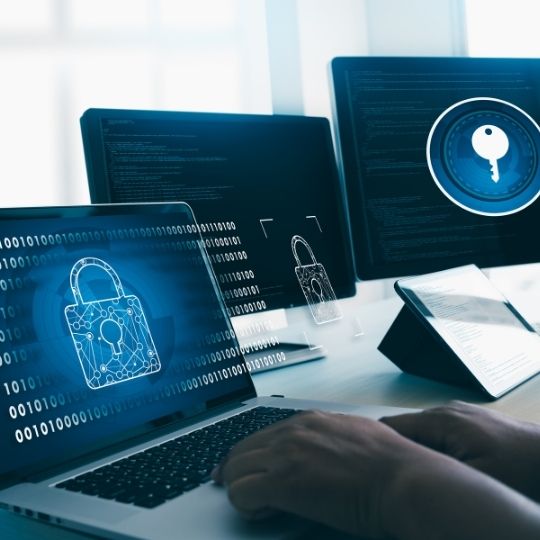Wooden Spoon: Blog

What Is Cybersecurity – Defining the Risks and Mitigating the Threats
Cybersecurity is nothing new for today’s risk-burdened businesses. However, what has changed is the sophistication and intensity of attacks in recent years―particularly amid the ongoing COVID-19 pandemic.
Security breaches related to data theft and loss of intellectual property are costly and wide-ranging, affecting employees, customers, the organization’s reputation, and bottom line. Furthermore, hackers and other cybercriminals continue to discover new ways to profit from sensitive data, these assets are becoming increasingly more attractive and sought-after targets.
What is Cybersecurity and What are the Threats?
 Although cybersecurity is only one component of information security (along with physical security), it tends to garner the most publicity. This is because cyber-attacks seem to be far more prevalent and successful than physical ones. Information security is focused on protecting data in any form. However, cybersecurity is concerned with safeguarding data found in electronic form.
Although cybersecurity is only one component of information security (along with physical security), it tends to garner the most publicity. This is because cyber-attacks seem to be far more prevalent and successful than physical ones. Information security is focused on protecting data in any form. However, cybersecurity is concerned with safeguarding data found in electronic form.
Cybersecurity is meant to protect anything vulnerable to manipulation, attacks, or unauthorized access from inside and outside an organization. Cyberattacks can originate from a variety of sources, from lone hackers to state-sponsored cybercriminals. Attacks are instigated using a variety of different methods such as phishing, malware, spyware, and ransomware.
Cybercriminals are constantly looking for new ways to break through your defenses, which reinforces the need to create a strong culture of security knowledge, awareness, and responsiveness. Ideally, you want to make sure your cybersecurity is handled by professionals who are trained to help you define your data priorities, identify areas of risk, and implement a security framework that aligns with your business goals.
Implementing Best Practice Measures
While cybersecurity and physical data security each have distinct areas of focus, they aren’t entirely separate. The risk of a stolen device is a good example. Physical security plays an essential role by helping to prevent devices from theft or unauthorized access. These measures include policies and protocols that provide employees direction on how to manage and safeguard their digital devices outside the protection of the physical premises.
However, these practices should work in conjunction with cybersecurity measures that protect data and assets should a device be lost or stolen. These measures include encryption of sensitive data, password protection, and implementing a kill mechanism to remotely wipe lost or stolen devices.
Having a comprehensive cybersecurity strategy in place to safeguard digital assets has become a core component of smart IT planning. Following some proven best practice measures can help protect mission-critical systems and confidential data.
Best Practices Measures You Should Consider
- Identify, map, and prioritize intellectual property and high-value data assets within digital systems. This includes data stored onsite as well as in the cloud.
- Safeguard data by implementing advanced threat detection techniques to identify weaknesses and irregularities within applications, digital systems, and devices.
- Remain up to date on the latest cybersecurity threats. Establish core security protocols and procedures and create usage policies that define acceptable and unacceptable behaviors.
- Perform risk assessments regularly to assess and evaluate best practices for safeguarding intellectual property. Implement policies for critical data recovery in the event of data loss or a security breach.
- Understand the risks associated with emerging technologies like big data and the Internet of Things. Prepare action plans and be ready to respond quickly and decisively to potential and actual threats.
- Become educated on privacy regulations and the legalities of protecting confidential information. Make sure you understand the liability implications surrounding cybersecurity for your industry and market.
Building a Cybersecurity Framework
As cybersecurity becomes more complex, many organizations lack the resources or knowledge they need to mount an effective defense. That’s how working with an experienced security expert can play a vital role, helping you establish a secure and well-protected digital environment.
Building a solid cybersecurity framework requires sophisticated tools and techniques and an operating culture that not only prioritizes data security, but helps improve business agility, transparency, and responsiveness. The best plans begin with a comprehensive assessment of your business systems and infrastructure and core security requirements.
Basic Areas to Review for Your Framework
- Assessment: For starters, it’s crucial to gain a clear picture of your data. This includes how you store it and access it. Evaluate how critical it is to your business, and the potential risks if the data is lost or stolen. What types of data are most vital to your business? What is the level of confidentiality of the data you manage? Are you using the best protocols for data access? This insight provides the framework for defining your security requirements and creating a plan that strikes an optimum balance between data protection and access flexibility.
- Controls: Digital files and applications require robust defenses such as access controls and user authentication to ensure that only approved users can view them. They can also help shield the network from potential threats with their ability to block departing employees from access to critical business systems and apps. Encryption has also proven effective in helping to safeguard data and provide an additional protective barrier to network-based attacks.
- Monitoring: At the heart of a proactive cybersecurity strategy is the ability to monitor events and respond to incidents based on that data. Proactive monitoring can help uncover security vulnerabilities and provide insight into how best to close these gaps. Automated monitoring capabilities can also play a vital role. They help to track user activity and access details. This information provides vital insight into types of risks and potential causes.
- Policies and procedures: The front-line users who interact with applications and systems must also know how to use technology safely and securely. That’s where the right cybersecurity expert can prove instrumental. They can help create and implement protocols and policies based on user and company preferences. These experts are also knowledgeable on regulatory requirements relative to your industry sector.
Staying Ahead of the Cybersecurity Curve
A comprehensive cybersecurity strategy is no longer a flexible option, but rather a must-have plan for businesses of all sizes. Every business environment is different, and cybercriminals are constantly improving their skills. Therefore, you must stay current on the latest security practices techniques. This means continuing to protect your business data and safeguard your systems from today’s unrelenting barrage of attacks.
At the center of the best cybersecurity strategy is a proactive approach that focuses on identifying vulnerabilities. This also includes implementing best practices and remaining diligent in mitigating threats and ensuring business continuity. The good news is that with the right blend of smart policies, solid technology planning, and the proper defensive measures, achieving effective protection against today’s cybersecurity threats is possible.






